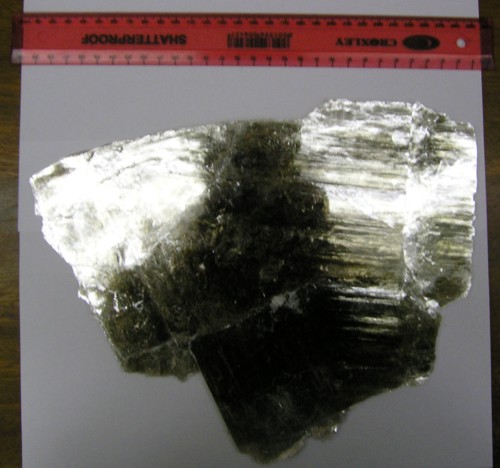So how big was that muscovite from last Friday’s geopuzzle? This big:

Yes, that is a 30 cm ruler running along the top of that image, which probably makes Greg’s guess the closest (if I rule out Divalent’s cunning attempt to claim ‘any other size not claimed by anyone else’, of course), so he can award himself 25 points and a jelly baby.
This not-so-little beauty was collected from a pegmatite quarry somewhere in Northern Cape. Pegmatite is actually a textural term, meaning ‘igneous rock with stupidly large crystals in it’, but they are most commonly granitic in composition, with lots of quartz and feldspar. They generally form pods or dyke-like veins both within intrusions, and in the surrounding country rock; the picture below (from another quarry in the same area) shows pegmatite veins intruding into a schist.

Pegmatites are generally thought* to form from the last few remants of a melt to crystallise, thus they are intimately related to the granites that they often seem to intrude. By this stage, the removal of lots of anhydrous minerals like quartz and feldspar from the melt has ramped up the volatile content; this lowers the freezing point of the remaining magma, but perhaps more importantly inhibits the nucleation of new crystals and greatly increases the diffusion rates of elements still in solution. All of these factors tend to produce larger crystals (sometimes more than a metre across); I’m somewhat reminded of how spinifex textures are produced in komatiites, although in that case higher melt temperatures are thought to be the culprit. Late hydrous melts also tend to be rich in elements with large ionic radius and charge, which includes the rare earth elements, and also produce nice gemstones such as tourmaline, hence they can be of some economic importance. However, the quarry that I got this particular mica from was making its money – and lots of it too, according to the owner – from something seemingly more mundane: decorative gravel for landscaping gardens.
Of course, all that pales into insignificance beside the fact that it’s very large and (being a mica) very shiny. I’m actually hoping to frame this between two sheets of glass and firmly establish my geonerdy credentials by hanging it on my office wall. I wonder if any of my fellow geoblogospherians can top that with their existing office art.
*at least, this is one of the theories; see this page for some others.



Comments (4)